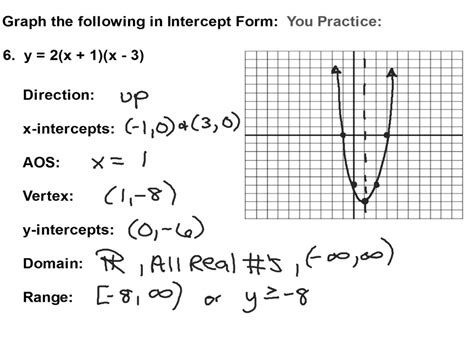Quadratic functions are a fundamental concept in algebra, and understanding them is crucial for solving various mathematical problems. One of the key forms of quadratic functions is the intercept form, which provides valuable insights into the behavior of these functions. In this article, we will delve into the world of quadratic functions in intercept form, explaining the concept in simple terms, highlighting its benefits, and providing practical examples to reinforce your understanding.
What is a Quadratic Function?

A quadratic function is a polynomial function of degree two, which means the highest power of the variable (usually x) is two. The general form of a quadratic function is f(x) = ax^2 + bx + c, where a, b, and c are constants, and a cannot be zero. Quadratic functions can be represented graphically as a parabola, which is a U-shaped curve that opens upwards or downwards.
What is Intercept Form?

The intercept form of a quadratic function is a way of expressing the function in terms of its x-intercepts. The x-intercepts are the points where the graph of the function crosses the x-axis. The intercept form is written as f(x) = a(x - r)(x - s), where r and s are the x-intercepts, and a is a constant.
Benefits of Intercept Form
The intercept form has several benefits that make it a useful way to express quadratic functions. Some of the advantages include:
- Easy identification of x-intercepts: The intercept form clearly shows the x-intercepts of the function, which is essential for understanding the behavior of the function.
- Simplified graphing: The intercept form makes it easy to graph the function, as the x-intercepts provide a clear starting point.
- Easy calculation of function values: The intercept form allows for easy calculation of function values, as the function can be evaluated at specific points.
How to Convert Standard Form to Intercept Form

To convert a quadratic function from standard form to intercept form, you need to factor the quadratic expression. Factoring involves expressing the quadratic expression as a product of two binomials. Here's a step-by-step guide:
- Write the quadratic expression in standard form: f(x) = ax^2 + bx + c
- Factor the quadratic expression: f(x) = a(x - r)(x - s)
- Identify the x-intercepts: The x-intercepts are the values of x that make the function equal to zero.
Example: Converting Standard Form to Intercept Form
Suppose we have a quadratic function in standard form: f(x) = x^2 + 5x + 6. To convert it to intercept form, we need to factor the quadratic expression:
f(x) = x^2 + 5x + 6 = (x + 2)(x + 3)
The x-intercepts are x = -2 and x = -3. Therefore, the intercept form of the function is:
f(x) = (x + 2)(x + 3)
Graphing Quadratic Functions in Intercept Form

Graphing a quadratic function in intercept form is relatively straightforward. Here's a step-by-step guide:
- Plot the x-intercepts: Plot the x-intercepts on the x-axis.
- Plot the vertex: The vertex is the point where the parabola changes direction. To find the vertex, use the formula x = -b / 2a.
- Draw the parabola: Draw the parabola by connecting the x-intercepts and the vertex.
Example: Graphing a Quadratic Function in Intercept Form
Suppose we have a quadratic function in intercept form: f(x) = (x + 2)(x + 3). To graph the function, we need to plot the x-intercepts and the vertex:
x-intercepts: x = -2 and x = -3 Vertex: x = -2.5
Plot the x-intercepts and the vertex on the coordinate plane, and draw the parabola by connecting the points.
Real-World Applications of Quadratic Functions

Quadratic functions have numerous real-world applications in physics, engineering, economics, and computer science. Some examples include:
- Projectile motion: Quadratic functions can be used to model the trajectory of projectiles, such as the path of a thrown ball.
- Electrical circuits: Quadratic functions can be used to analyze electrical circuits, such as the voltage across a resistor.
- Optimization problems: Quadratic functions can be used to solve optimization problems, such as finding the maximum or minimum value of a function.
Example: Modeling Projectile Motion with Quadratic Functions
Suppose we want to model the trajectory of a thrown ball. We can use a quadratic function to describe the height of the ball as a function of time:
h(t) = -4.9t^2 + 20t + 1
This function describes the height of the ball at time t. We can use this function to calculate the maximum height of the ball, the time it takes to reach the maximum height, and the range of the ball.
Now that you've reached the end of this article, we hope you have a better understanding of quadratic functions in intercept form. Whether you're a student, teacher, or simply someone interested in mathematics, we encourage you to share your thoughts, ask questions, or provide examples of how you've used quadratic functions in your own life.
What is the main benefit of using intercept form for quadratic functions?
+The main benefit of using intercept form for quadratic functions is that it provides a clear and easy way to identify the x-intercepts of the function, which is essential for understanding the behavior of the function.
How do I convert a quadratic function from standard form to intercept form?
+To convert a quadratic function from standard form to intercept form, you need to factor the quadratic expression. Factoring involves expressing the quadratic expression as a product of two binomials.
What are some real-world applications of quadratic functions?
+Quadratic functions have numerous real-world applications in physics, engineering, economics, and computer science, including projectile motion, electrical circuits, and optimization problems.
